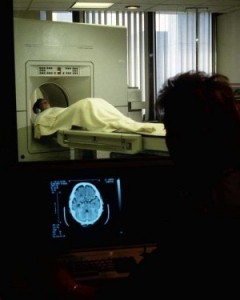 Cine MRI (as in cinema) is taken the same way a traditional MRI is, with the addition of either a wristband or EKG leads on the patient’s chest to measure the heart rate. Each time your heart beats, the cerebrospinal fluid is forced out of your brain, down toward the spine in response to the flow of blood that enters the brain with each beat. The MRI machine is equipped with an additional software package that allows the images to be put together, showing the flow of the cerebrospinal fluid (CSF) as it is moving.
Cine MRI (as in cinema) is taken the same way a traditional MRI is, with the addition of either a wristband or EKG leads on the patient’s chest to measure the heart rate. Each time your heart beats, the cerebrospinal fluid is forced out of your brain, down toward the spine in response to the flow of blood that enters the brain with each beat. The MRI machine is equipped with an additional software package that allows the images to be put together, showing the flow of the cerebrospinal fluid (CSF) as it is moving.
Cine MRI’s are sometimes ordered for patients to help doctors determine the amount of CSF flow through the foramen magnum. It can be useful in cases of “borderline” Chiari Malformations or when the question of whether or not decompression is needed is not readily answered using a traditional MRI. A radiologist can determine the amount of fluid that is moving and compare that with normal subjects. Cine MRI’s are sometimes useful in showing other CSF blockages as well. Cine MRI’s are not readily available to all patients, and their practical use is still debated by physicians.

